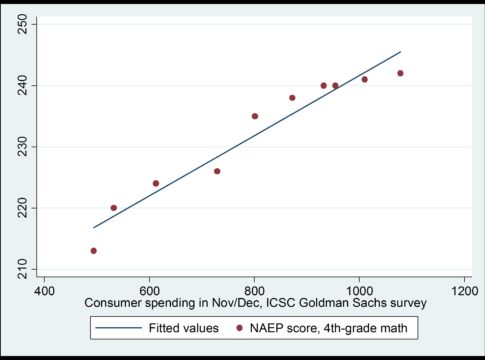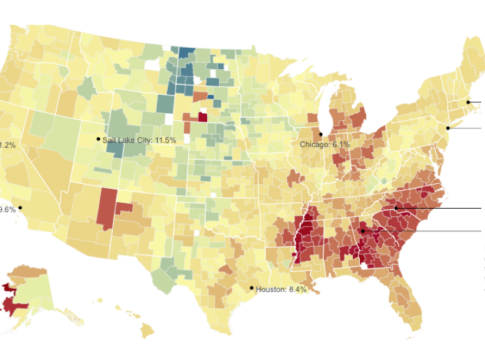One big idea animates virtually all of today’s earnest education reformers: the conviction that great schools can spur social mobility. Voucher supporters, charter advocates, standards nuts, teacher-effectiveness fanatics—we all fundamentally believe that fantastic schools staffed by dedicated educators can help poor kids climb out of poverty and compete with their affluent peers. And then Charles Murray comes along and throws cold water all over the idea.
This was my reaction last month when Murray visited the Fordham Institute to talk about his latest book, Coming Apart: The State of White America, 1960-2010. Among his many interesting and provocative comments about the rise of a “new upper class”—one inhabited by the winners of America’s meritocracy—he made this rather disturbing statement: “The better the meritocracy, the faster social mobility will decline.” Checker Finn, our president and moderator, did a double-take. “Say it again?” So Murray did. “The better the meritocracy, the more efficiently you identify and reward talent, the faster that social mobility will decline over time.”
As it turns out, this wasn’t the first time Murray has made that argument. An earlier version can be found in his controversial book, The Bell Curve, written with Richard Hernnstein, and then restated in a 2010 Washington Post op-ed:
The more efficiently a society identifies the most able young people of both sexes, sends them to the best colleges, unleashes them into an economy that is tailor-made for people with their abilities and lets proximity take its course, the sooner a New Elite—the “cognitive elite” that Herrnstein and I described—becomes a class unto itself. It is by no means a closed club, as Barack Obama’s example proves. But the credentials for admission are increasingly held by the children of those who are already members. An elite that passes only money to the next generation is evanescent (“Shirtsleeves to shirtsleeves in three generations,” as the adage has it). An elite that also passes on ability is more tenacious, and the chasm between it and the rest of society widens.
Which is why, Murray argues, that the children of the New Elite dominate the campuses of top-tier universities.
The student bodies of the elite colleges are still drawn overwhelmingly from the upper middle class. According to sociologist Joseph Soares’s book “The Power of Privilege: Yale and America’s Elite Colleges,” about four out of five students in the top tier of colleges have parents whose income, education and occupations put them in the top quarter of American families, according to Soares’s measure of socioeconomic status. Only about one out of 20 such students come from the bottom half of families.
The discomfiting explanation is that despite need-blind admissions policies, the stellar applicants still hail overwhelmingly from the upper middle class and above. Students who have a parent with a college degree accounted for only 55 percent of SAT-takers this year but got 87 percent of all the verbal and math scores above 700, according to unpublished data provided to me by the College Board. This is not a function of SAT prep courses available to the affluent—such coaching buys only a few dozen points—but of the ability of these students to do well in a challenging academic setting.
Read that again. Just one in 20 students at top universities comes from the bottom half of the socio-economic strata. The number coming from the bottom quintile—children growing up in poverty—is even smaller—miniscule really. Are we reformers kidding ourselves when we think that better schools will catapult low-income children into the ranks of this New Elite?
Our argument, as it goes, is that we’ve never really tried. Because of low expectations, mediocre teachers, a lack of options, ill-designed curricula—name your poison—poor kids have never had a chance to see their talents flourish. Put them into the right educational environment, surround them with supportive adults, and (if you’re of the broader/bolder persuasion) provide them with all kinds of social supports too, and we’ll see our elite college campuses—gateways to the new Upper Class—democratize before our eyes.
But this assumes that academic ability—whether defined as intelligence, or non-cognitive skills and character traits, or whatever else—is randomly distributed across the population. Which, Murray argues, was probably once true but is no longer. Because of the ferocious sorting of the meritocratic machine, talented people have been finding and marrying one another, and giving birth to a super-class of highly gifted children. (Murray said at our event that it “doesn’t matter” whether these gifts are bequeathed by nature or nurture. What matters is the strong link between the talents of parents and the talents of their offspring.) And, as David Brooks pointed out today, after years of bedtime stories, trips to the zoo, vocabulary-packed conversations, and other “enrichment” activities, these children enter school miles ahead of the rest of their peers—including the poor kids that are the focus of so many education reforms.
Of course, as Murray says, this phenomenon plays out in terms of group averages. If we live in a meritocracy where intelligence and other talents lead to success,* then the children of the highly successful (the Elite) will, on average, be more talented than the children of the somewhat successful, who will, on average, be more talented that the children of the not successful (i.e., the children of the poor). On average.
Understandably, we don’t much like to discuss this possibility. It gives cover to educators who look at a classroom of low-income children and diminish their expectations—thinking that “these kids” aren’t capable of much, educators who don’t buy the mantra that “all children can learn.” But would we be shocked to find that the average intelligence level of such a classroom is lower than a classroom in an elite, affluent suburb?
Yes, intelligence is malleable, not innate. Yes, an exceptional school/teacher/curriculum may boost that average intelligence level. But can those factors boost it enough to overcome the disparities Murray describes? If not, what can educators do?
I see two possible strategies. The first is to be fanatical about identifying talented children from low-income (and middle-income) communities and then provide the challenge and support to launch them into the New Elite via top-tier universities. Murray, for one, thinks this is already happening. “If you are a really smart kid in a backwater town in Mississippi—I don’t care if you’re white or black—this has never been a better time for you,” he said at our event. “It’s never been easier for you, no matter how poor your family is, to get a full ride to a really good college if you’re really, if you’ve got a lot of talent. We’ve gotten really, really good at identifying talent wherever it is and I’m delighted about that.”
He may well be right. It’s true that many communities have various “talent search” initiatives, scholarship programs for poor kids to attend elite private schools and top colleges, science fairs, spelling bees, selective magnet schools, and other approaches for ferreting out these diamonds in the rough. (Some of the best charter schools might be playing this role too, though they don’t want to admit it.) Still, I worry that, in the current policy environment, most schools serving poor kids have little incentive to offer gifted-and-talented programs and other mechanisms whereby to boost the prospects of poor but brilliant kids. (Online learning could be a big help here.)
The second strategy is to be more realistic about the kind of social mobility we hope to spur. Getting a big chunk of America’s poor kids into the New Elite in one generation might be a fool’s errand—our meritocracy has put them at too great a disadvantage. But getting them into working -class or middle-class jobs isn’t so impossible. Here’s a question for the KIPPs and YES Preps of the world: Would you be happy if, ten years from now, your middle schoolers were working as cops, firefighters, teachers, plumbers, electricians, and nurses? This would be a huge accomplishment, it seems to me, as most poor kids will go on to work in low-paid service jobs a decade hence. It may not make for as inspiring a Hollywood story, but it’s a crucial version of social mobility all the same.
Maybe Murray’s wrong. I sort of hope that he is. But we should be talking about these issues all the same.
-Mike Petrilli
* The Left sees the same social sorting as Murray but concludes that our meritocracy isn’t efficient, it’s rigged. See, for example, Christopher Hayes’ The Twilight of the Elites, as excerpted in this Nation article.
This blog entry originally appeared on the Fordham Institute’s Flypaper blog.




